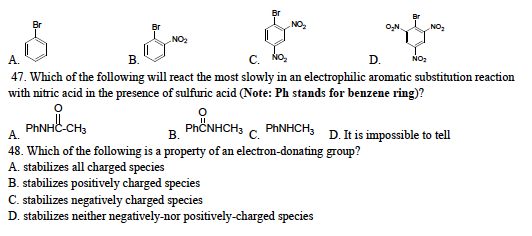.8 A. & NO₂2₂ NO₂ D. NO₂ 47. Which of the following will react the most slowly in an electrophilic aromatic substitution reaction with nitric acid in the presence of sulfuric acid (Note: Ph stands for benzene ring)? 요 PhCNHCH3 PhNHC-CH3 A. B. PhNHCH3 C. 48. Which of the following is a property of an electron-donating A. stabilizes all charged species B. stabilizes positively charged species C. stabilizes negatively charged species D. stabilizes neither negatively-nor positively-charged species D. It is impossible to tell group?
.8 A. & NO₂2₂ NO₂ D. NO₂ 47. Which of the following will react the most slowly in an electrophilic aromatic substitution reaction with nitric acid in the presence of sulfuric acid (Note: Ph stands for benzene ring)? 요 PhCNHCH3 PhNHC-CH3 A. B. PhNHCH3 C. 48. Which of the following is a property of an electron-donating A. stabilizes all charged species B. stabilizes positively charged species C. stabilizes negatively charged species D. stabilizes neither negatively-nor positively-charged species D. It is impossible to tell group?
Chemistry
10th Edition
ISBN:9781305957404
Author:Steven S. Zumdahl, Susan A. Zumdahl, Donald J. DeCoste
Publisher:Steven S. Zumdahl, Susan A. Zumdahl, Donald J. DeCoste
Chapter1: Chemical Foundations
Section: Chapter Questions
Problem 1RQ: Define and explain the differences between the following terms. a. law and theory b. theory and...
Related questions
Question

Transcribed Image Text:46. Which of the following is the least reactive to electrophilic aromatic substitution?

Transcribed Image Text:&
&
NO₂2₂
NO₂
A.
C.
D. NO₂
47. Which of the following will react the most slowly in an electrophilic aromatic substitution reaction
with nitric acid in the presence of sulfuric acid (Note: Ph stands for benzene ring)?
요
PhCNHCH3
PhNHC-CH3
A.
B.
PhNHCH3
C.
48. Which of the following is a property of an electron-donating group?
A. stabilizes all charged species
B. stabilizes positively charged species
C. stabilizes negatively charged species
D. stabilizes neither negatively-nor positively-charged species
D. It is impossible to tell
Expert Solution
This question has been solved!
Explore an expertly crafted, step-by-step solution for a thorough understanding of key concepts.
Step by step
Solved in 2 steps with 2 images

Knowledge Booster
Learn more about
Need a deep-dive on the concept behind this application? Look no further. Learn more about this topic, chemistry and related others by exploring similar questions and additional content below.Recommended textbooks for you

Chemistry
Chemistry
ISBN:
9781305957404
Author:
Steven S. Zumdahl, Susan A. Zumdahl, Donald J. DeCoste
Publisher:
Cengage Learning

Chemistry
Chemistry
ISBN:
9781259911156
Author:
Raymond Chang Dr., Jason Overby Professor
Publisher:
McGraw-Hill Education

Principles of Instrumental Analysis
Chemistry
ISBN:
9781305577213
Author:
Douglas A. Skoog, F. James Holler, Stanley R. Crouch
Publisher:
Cengage Learning

Chemistry
Chemistry
ISBN:
9781305957404
Author:
Steven S. Zumdahl, Susan A. Zumdahl, Donald J. DeCoste
Publisher:
Cengage Learning

Chemistry
Chemistry
ISBN:
9781259911156
Author:
Raymond Chang Dr., Jason Overby Professor
Publisher:
McGraw-Hill Education

Principles of Instrumental Analysis
Chemistry
ISBN:
9781305577213
Author:
Douglas A. Skoog, F. James Holler, Stanley R. Crouch
Publisher:
Cengage Learning

Organic Chemistry
Chemistry
ISBN:
9780078021558
Author:
Janice Gorzynski Smith Dr.
Publisher:
McGraw-Hill Education

Chemistry: Principles and Reactions
Chemistry
ISBN:
9781305079373
Author:
William L. Masterton, Cecile N. Hurley
Publisher:
Cengage Learning

Elementary Principles of Chemical Processes, Bind…
Chemistry
ISBN:
9781118431221
Author:
Richard M. Felder, Ronald W. Rousseau, Lisa G. Bullard
Publisher:
WILEY